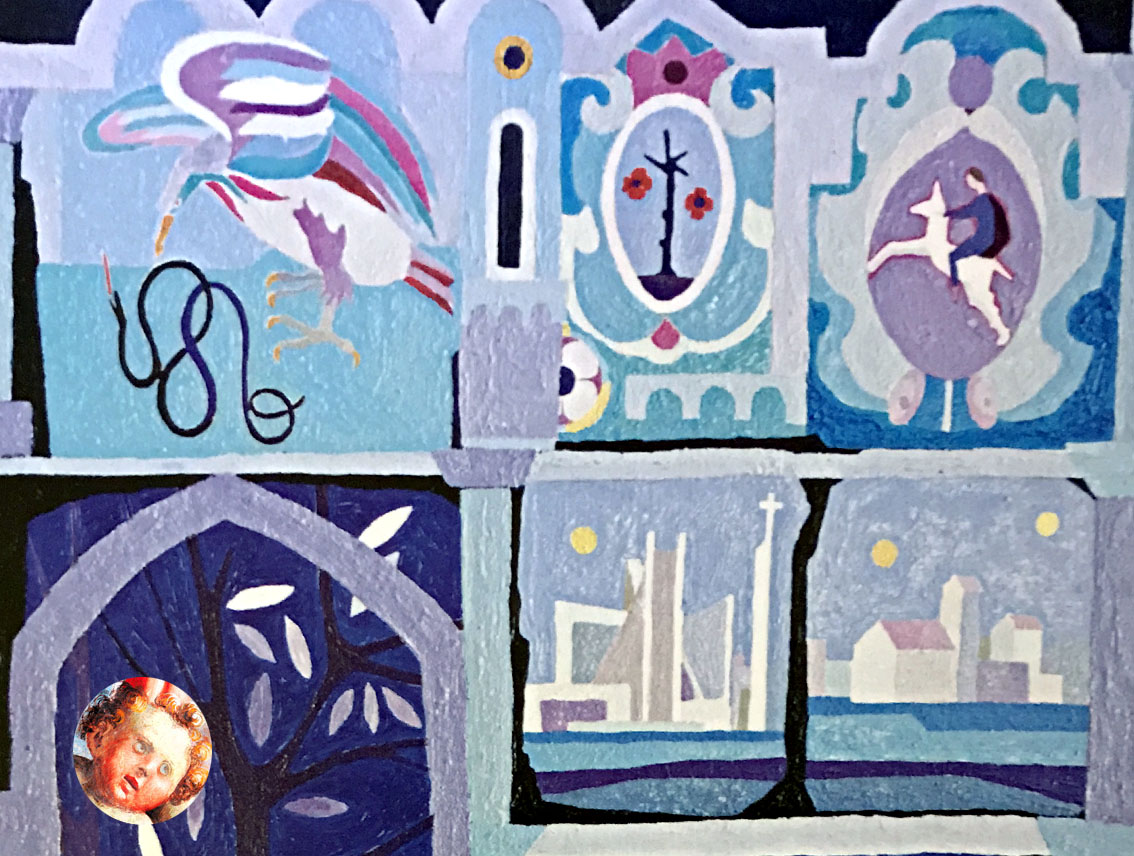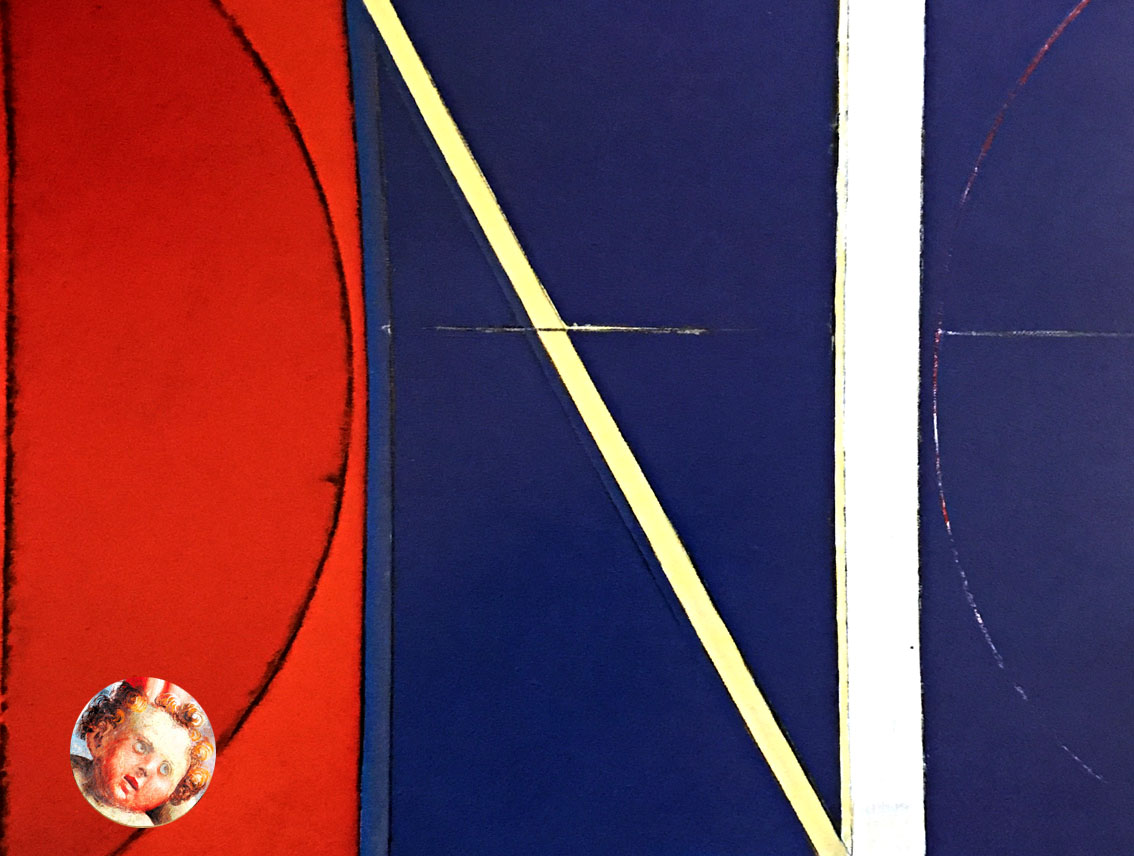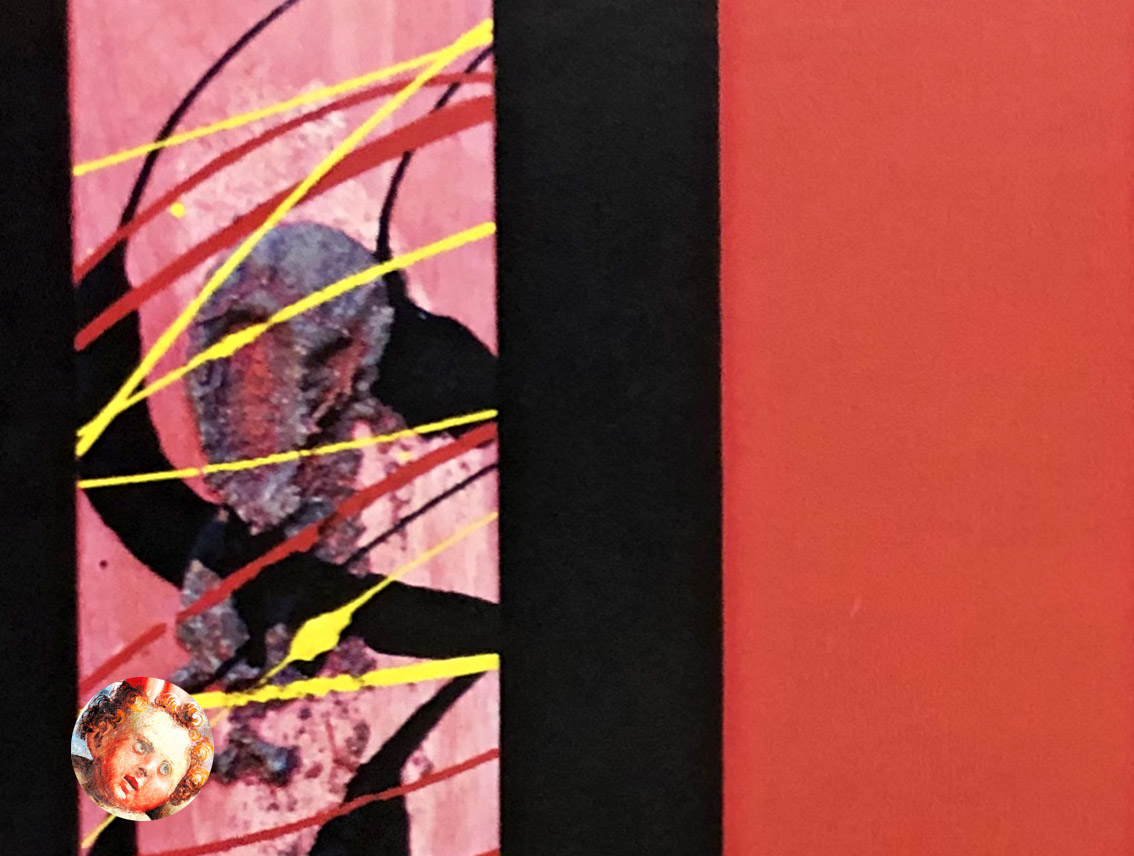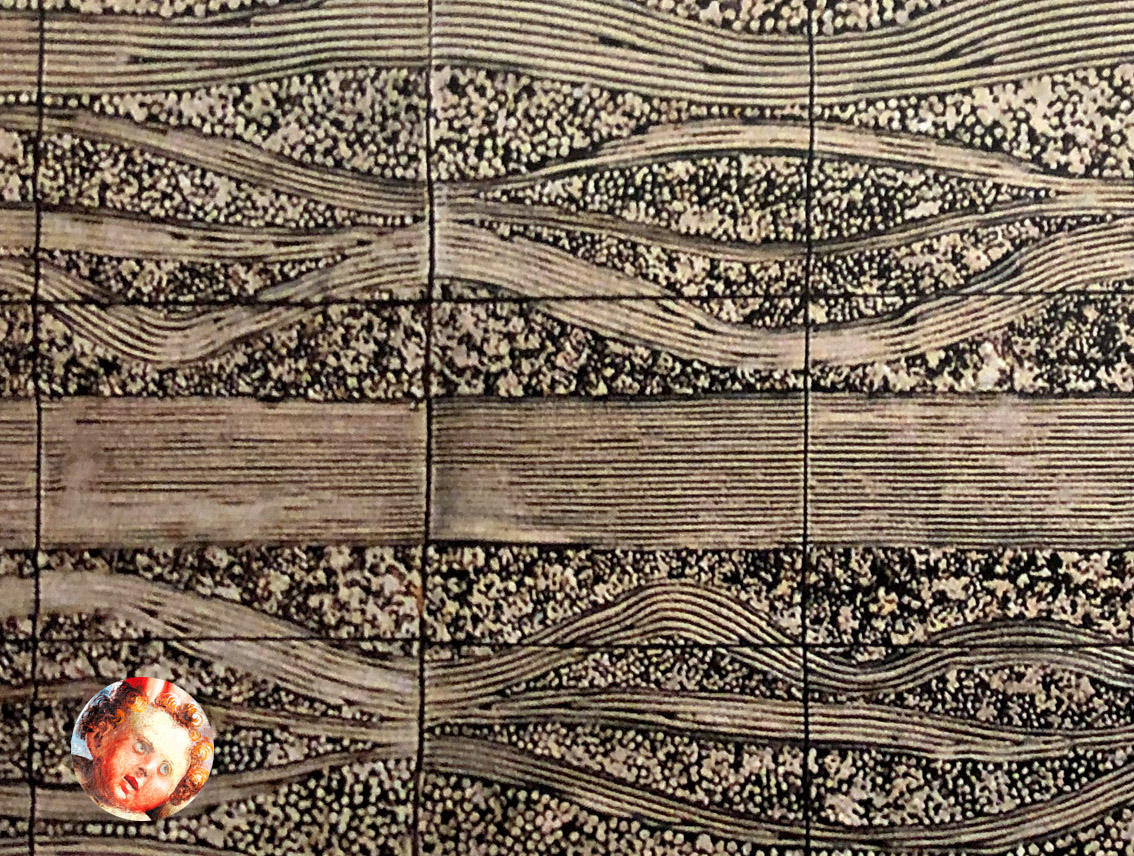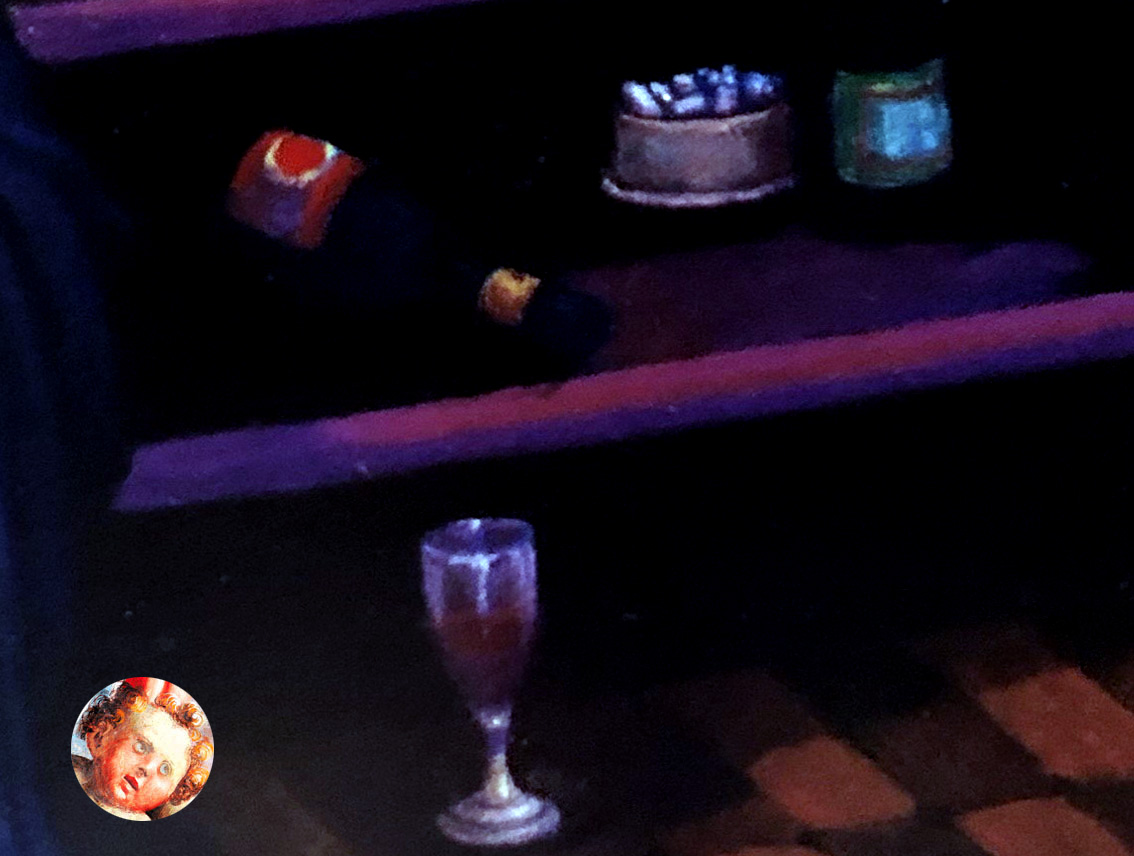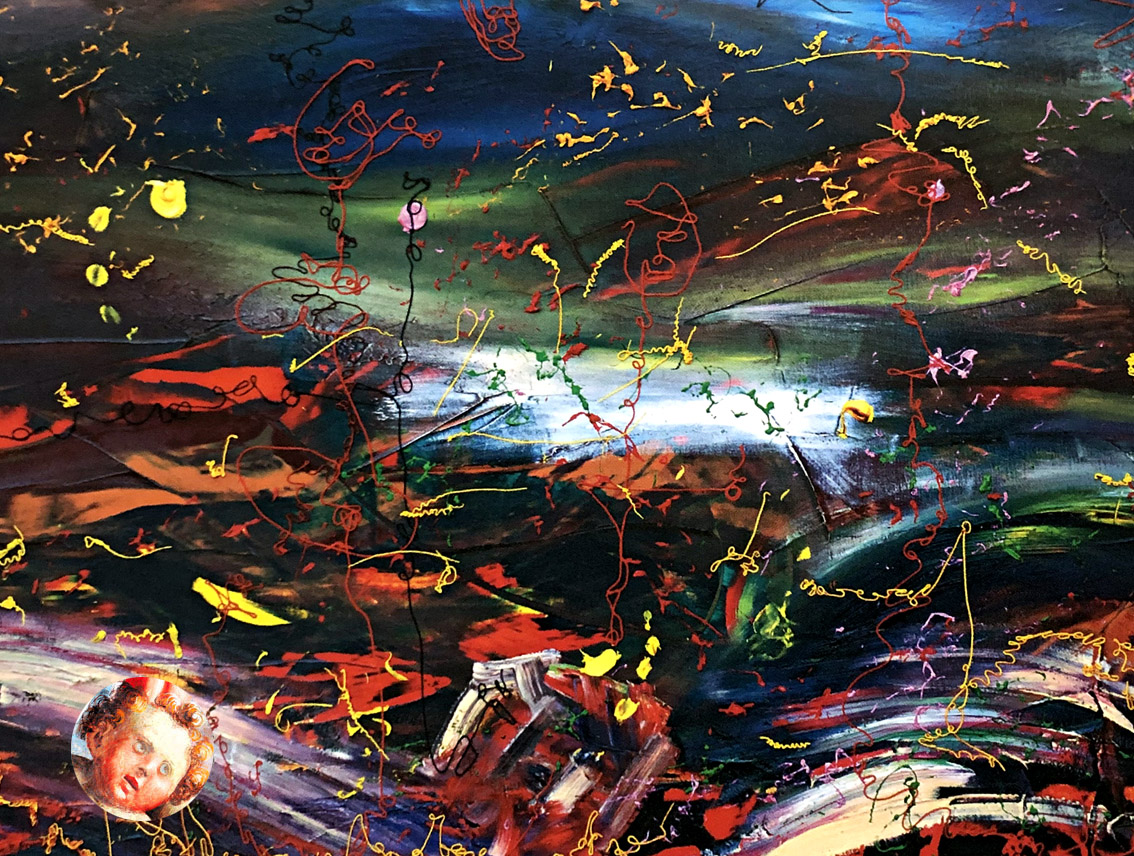
MOSTRA D'ARTE
GUGLIONESI 1-6 AGOSTO 2023
CHIOSTRO DEL CONVENTO DEI CAPPUCCINI
Ore 21.30-23.00 (ingresso libero)
SELEZIONE DALLA COLLEZIONE D'ARTE CONTEMPORANEA "CORRADO GIZZI" DEL COMUNE DI GUGLIONESI
A cura della Parrocchia di Santa Maria Maggiore
Logo Sapere Aude estratto grafico dall'opera di Felice Paolone
LA PRESENTAZIONE
|
Frammenti
Gabriella Albertini, 1995
Tecnica mista su tela, 70 x 50 cm  GUGLIONESIGUIDA CULTURALE E TURISTICA
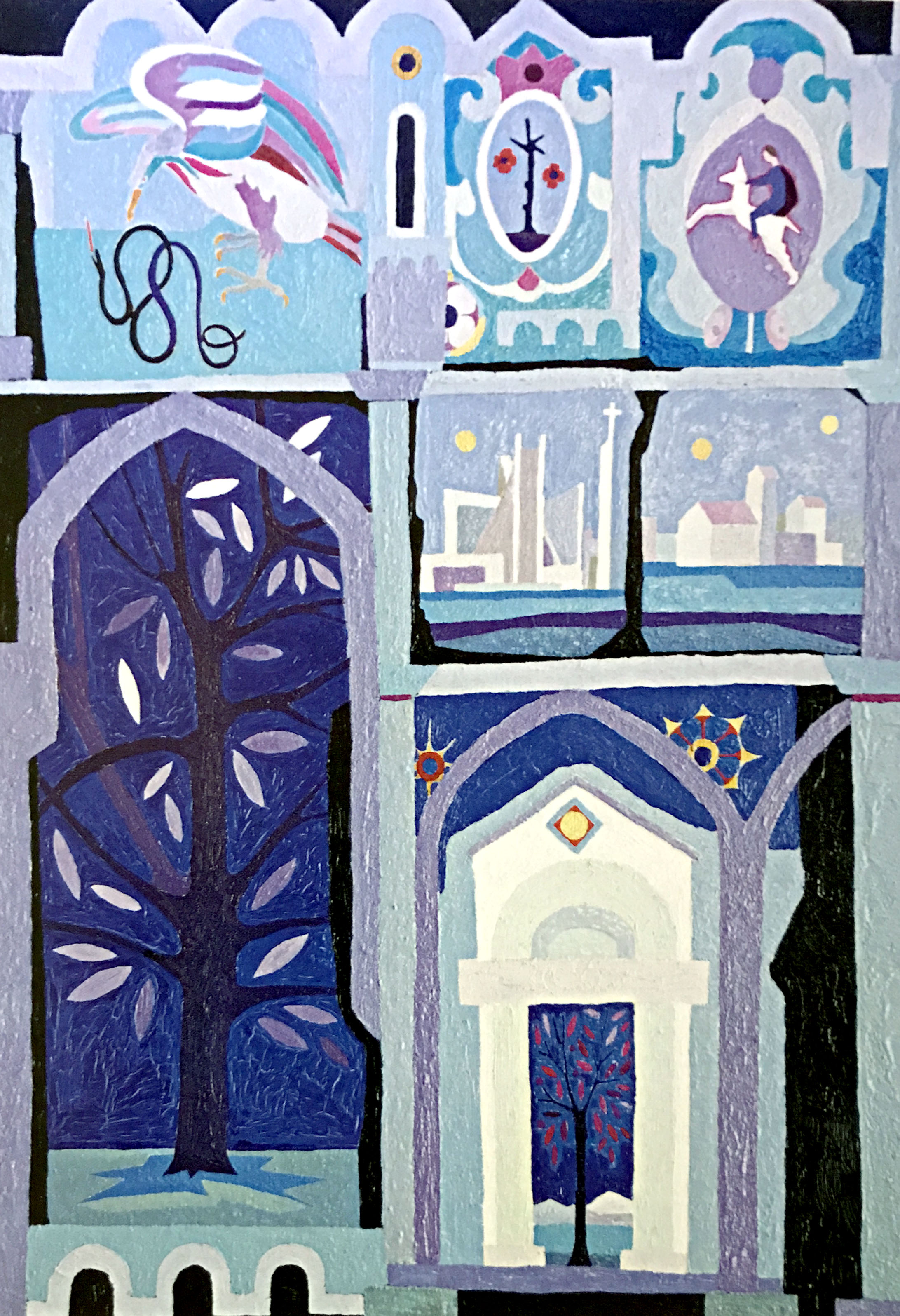
Frammenti
Gabriella Albertini, 1995
Tecnica mista su tela, 70 x 50 cm Gabriella Albertini (Pescara, 1935) - Incisore e pittrice, apprende le tecniche dell’incisione presso lo Studio Calcografico Urbino di Pescara. Opera nel campo dell’incisione dal 1977, mostrando una particolare predilezione per l’acquaforte. Il suo corpus calcografico comprende all’incirca 155 opere che rappresentano in genere figurazioni fantastiche. Stampa presso lo Studio Calcografico Urbino di Pescara.
È presente alle seguenti manifestazioni nazionali e internazionali: V Biennale Internazionale d’Arte Grafica “Fuoco”, Francavilla al Mare (CH). Sant Carles De La Rapita (E) 2008; 3° Beijing International Art Biennale, Pechino (Cina) 2008.
Nel 2008 ha allestito a Pescara la mostra personale Un bestiario immaginato.
GUGLIONESI CULTURA © LUIGI SORELLA [Bibliografia, Pinacoteca d'Arte Contemporanea "Corrado Gizzi": cat. / p. 16]  GUGLIONESIGUIDA CULTURALE E TURISTICA

Fragments Gabriella Albertini (Pescara, 1935) - Engraver and painter, she learned the techniques of engraving at the Urbino Chalcographic Studio in Pescara. He has been working in the field of engraving since 1977, showing a particular predilection for etching. His chalcographic corpus includes approximately 155 works that generally represent fantastic figurations. Printing at the Urbino Calcographic Studio in Pescara.
It is present at the following national and international events: V International Biennial of Graphic Art "Fuoco", Francavilla al Mare (CH). Sant Carles De La Rapita (E) 2008; 3rd Beijing International Art Biennale, Beijing (China) 2008.
In 2008 he set up the personal exhibition Un bestiary imagined in Pescara.
[Bibliography, "Corrado Gizzi" Contemporary Art Gallery: cat. / p. 16]
Ritratto di Dante
Bruno Aller, 2007
Olio, 50 x 60 cm  GUGLIONESIGUIDA CULTURALE E TURISTICA
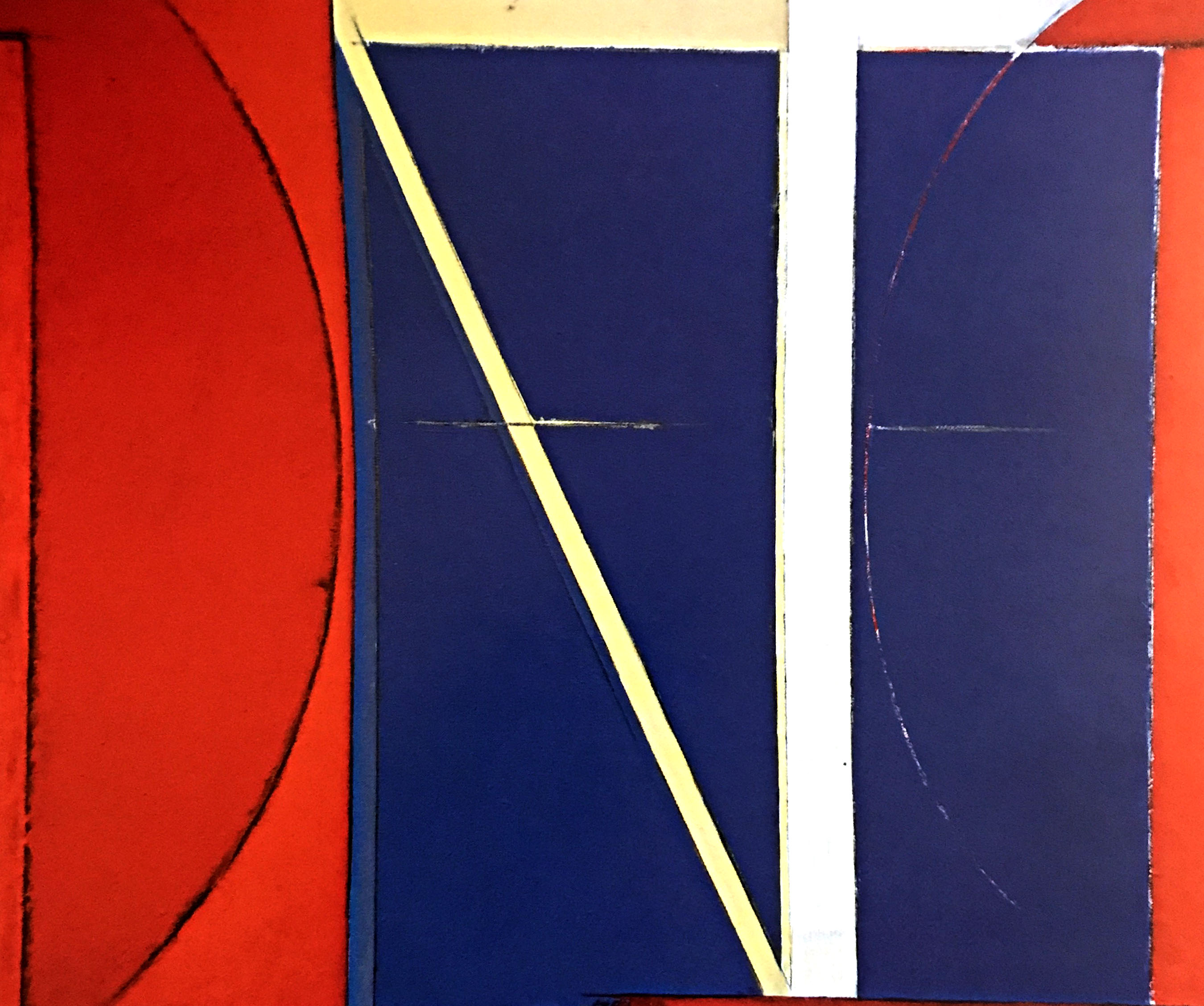
Ritratto di Dante
Bruno Aller, 2007
Olio, 50 x 60 cm Bruno Aller (Roma, 1960) - Pittore ed incisore, grande maestro dell'astrazione pittorica. Le sue opere sono contraddistinte dal segno e dal gesto, dalla stesura del colore per stratificazione. Tra le numerose mostre personali e collettive a cui ha partecipato si ricordano: (Personali) 'Diario' CIAC M21 Caserta; 'Ipnosomi' Zoe Arte, Roma; 'Napoli Visionaria' Napoli; 'Miserabilia Urbis' Roma; 'Metamorfosi', Jolly Hotel Art, Roma; 'Segni-Strutture' Palazzo dei Frentani, Roma; 'Poiesis Klee' Galleria il Salice, Locarno (CH); 'Ri/Tratti' Galleria Delloro, Roma; 'Opere' Istituto Italiano di Cultura S.Francisco (USA); Biblioteca Vallicelliana, Roma; 'Opere dal 1979 al 2009' Castel dell'Ovo, Napoli; 'Jus Opera' Palazzetto Art Gallery, Roma; Honos Art. (Collettive) XLVI, XLVII, XLVIII e LII Mostra Nazionale Termoli (Cb); Sei artisti all'Università di Akron Akron (Ohio-Usa); XXIX Premio Sulmona Sulmona (Aq; 32 Artisti per Vlado Gotovac Accademia di Romania, Roma; Tutti Puzzles per l'Arte Gall. 'Arte e Pensieri' e Università di Tor Vergata, Roma; Omaggio a Vlado Gotovac Museo Klovicevi Dvori, Zagabria (HR); 21 Artisti romani per Lipik Lipik (HR); Stromungen Galerie 'Die Brucke', Ulm (D); Freud/ Schnitzler Forum Austriaco di Cultura, Roma; Riflessioni sulla pittura Istituto Cultura Italiano, San Francisco USA; Vitalità dell'astrattismo in Italia Songzhuang VI Festival Internazionale delle Arti, Pechino; Artisti a Palazzo Palazzo dei Normanni, Palermo; Il segno Inciso Astrattisti a Roma, Simone Aleandri Arte moderna Roma; Framment-azione Bau Art Basel (CH); Farnesina e le sue collezioni Londra.
GUGLIONESI CULTURA © LUIGI SORELLA [Bibliografia, Pinacoteca d'Arte Contemporanea "Corrado Gizzi": cat. / p. 17]  GUGLIONESIGUIDA CULTURALE E TURISTICA

Portrait of Dante Bruno Aller (Rome, 1960) - Painter and engraver, great master of pictorial abstraction. His works are characterized by the sign and the gesture, by the application of color by layering. Among the numerous personal and collective exhibitions in which he has participated, the following are worth mentioning: (Personal) 'Diary' CIAC M21 Caserta; 'Hypnosomes' Zoe Arte, Rome; 'Naples Visionaria' Naples; 'Miserabilia Urbis' Rome; 'Metamorphosis', Jolly Hotel Art, Rome; 'Signs-Structures' Palazzo dei Frentani, Rome; 'Poiesis Klee' Il Salice Gallery, Locarno (CH); 'Ri / Tratti' Galleria Delloro, Rome; 'Works' Italian Cultural Institute San Francisco (USA); Vallicelliana Library, Rome; 'Works from 1979 to 2009' Castel dell'Ovo, Naples; 'Jus Opera' Palazzetto Art Gallery, Rome; Honos Art. (Collective) XLVI, XLVII, XLVIII and LII National Exhibition Termoli (Cb); Six artists at the University of Akron Akron (Ohio-USA); XXIX Sulmona Prize Sulmona (Aq; 32 Artists for Vlado Gotovac Academy of Romania, Rome; All Puzzles for Art Gall. 'Art and Thoughts' and University of Tor Vergata, Rome; Tribute to Vlado Gotovac Klovicevi Dvori Museum, Zagreb (HR ); 21 Roman artists for Lipik Lipik (HR); Stromungen Galerie 'Die Brucke', Ulm (D); Freud / Schnitzler Austrian Culture Forum, Rome; Reflections on painting Istituto Cultura Italiano, San Francisco USA; Vitality of abstract art in Italy Songzhuang VI International Festival of Arts, Beijing; Artists at Palazzo Palazzo dei Normanni, Palermo; The engraved sign Abstractionists in Rome, Simone Aleandri Modern art Rome; Fragment-action Bau Art Basel (CH); Farnesina and its collections London.
[Bibliography, "Corrado Gizzi" Contemporary Art Gallery: cat. / p. 17]
Opera n. 29
Renzo Eusebi, 2004
Polimaterico, 70 x 70 cm  GUGLIONESIGUIDA CULTURALE E TURISTICA
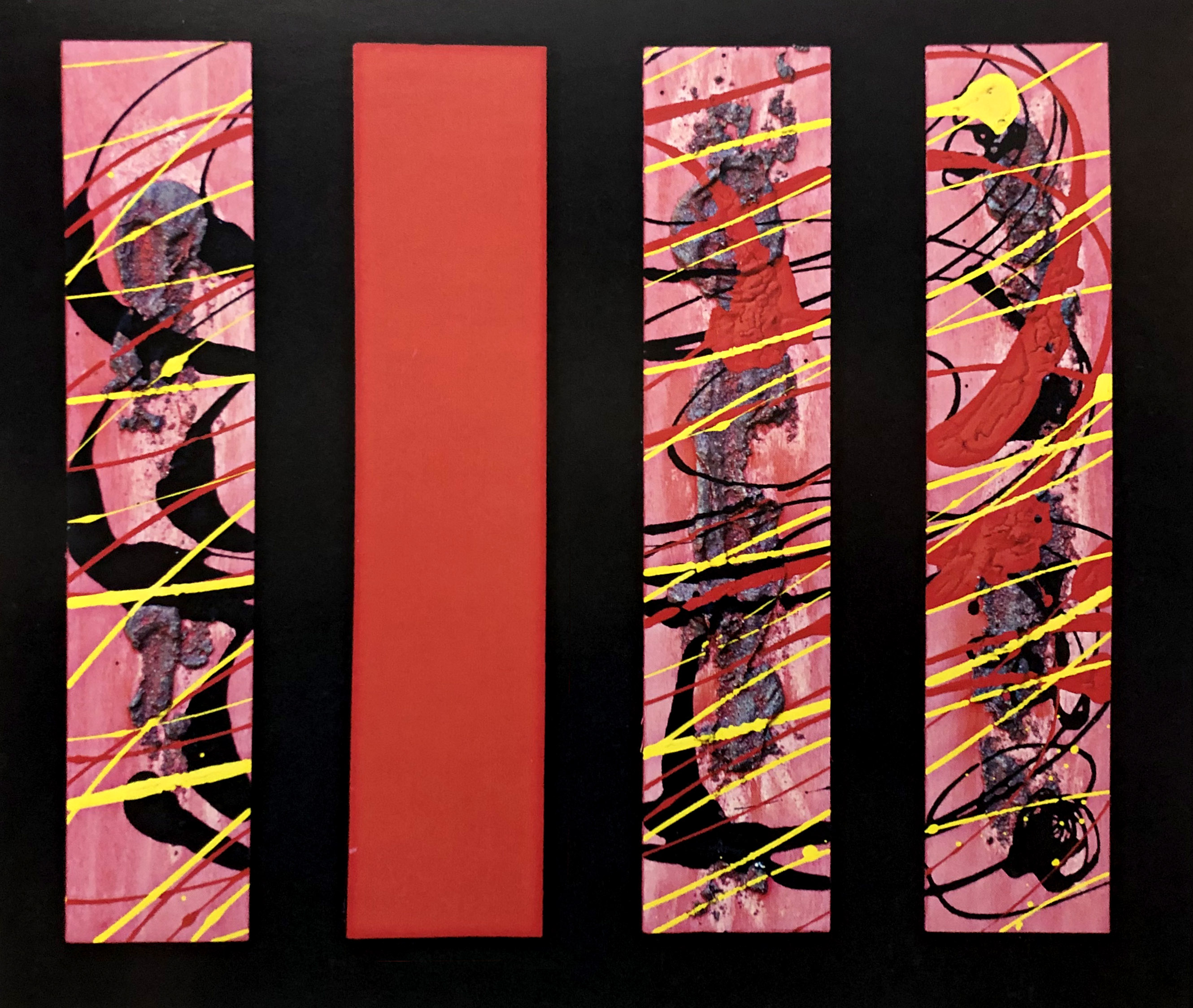
Opera n. 29
Renzo Eusebi, 2004
Polimaterico, 70 x 70 cm Renzo Eusebi (Patrignone, 18 aprile 1946) - Eusebi è un pittore e scultore italiano. La sua figura artistica di pittore e scultore è legata ai movimenti artistici del Transvisionismo (1995) e del GAD - Gruppo Aniconismo Dialettico (1997), curato da Giorgio Di Genova.
Nasce a Patrignone, frazione di Montalto Marche, il 18 aprile 1946. Nel 1962 frequenta il liceo artistico a Roma e stringe amicizia con Sante Monachesi. Si cimenta agli inizi nel bassorilievo in gesso, usa la spatola, realizza una serie di dipinti ottenendo un quadro frantumato. Dopo gli esordi neosurrealisti, in cui declinava in modi personali sia la lezione dei Buchi di Lucio Fontana sia il materismo di Alberto Burri, approda ad un periodo di dipinti materici, monocromatici, e di metalliche sculture dipinte, giungendo progressivamente a prosciugare la materia pittorica in stesure piane e compatte dei tre colori primari, si evolve sulla lezione neoplastica di Piet Mondrian, che lo ha fatto approdare ad un purismo pittorico pulito, illuminato. Dagli anni Settanta ad oggi è presente con le sue opere in numerose mostre collettive e personali, nazionali e internazionali dei suoi percorsi artistici. Negli anni Ottanta in particolare si dedica alla ricerca di una pittura astratta, surrealista, dove si intrecciano spirali da cui emergono forme geometriche di colori rosso, nero, giallo e blu, immagini e colori primari. La sua figura è legata ai movimenti artistici del Transvisionismo (1995) e in modo particolare del Gruppo Aniconismo Dialettico (GAD), fondato in Arte Fiera, Bologna, nel 1997, pubblicato su Bora Edizioni, curato da Giorgio Di Genova, il quale seleziona accuratamente cinque artisti italiani emergenti: Renzo Eusebi, Pasquale Di Fabio, Walter Coccetta, Antonio Di Girolamo e Pitti..
GUGLIONESI CULTURA © LUIGI SORELLA [Bibliografia, Pinacoteca d'Arte Contemporanea "Corrado Gizzi": cat. / p. 71]  GUGLIONESIGUIDA CULTURALE E TURISTICA

Work n. 29 Renzo Eusebi (Patrignone, 18 aprile 1946) - Renzo Eusebi is an Italian painter and sculptor. His artistic figure as a painter and sculptor is linked to the artistic movements of Transvisionism (1995) and GAD - Gruppo Aniconismo Dialettico (1997), curated by Giorgio Di Genova.
He was born in Patrignone, a hamlet of Montalto Marche, on April 18, 1946. In 1962 he attended the art school in Rome and became friends with Sante Monachesi. At the beginning he tries his hand at plaster bas-relief, using the spatula, he creates a series of paintings obtaining a shattered picture. After the neo-surrealist beginnings, in which he declined in personal ways both the lesson of Lucio Fontana's Holes and the materialism of Alberto Burri, he arrives at a period of material, monochromatic paintings and painted metallic sculptures, progressively arriving at drying up the pictorial material in flat and compact layers of the three primary colors, evolves on the neoplastic lesson of Piet Mondrian, which led him to arrive at a clean, enlightened pictorial purism. From the seventies to today he is present with his works in numerous group and personal, national and international exhibitions of his artistic careers. In the 1980s in particular he devoted himself to the search for an abstract, surrealist painting, where spirals intertwine from which geometric shapes of red, black, yellow and blue colors emerge, images and primary colors. His figure is linked to the artistic movements of Transvisionism (1995) and in particular to the Dialectic Aniconism Group (GAD), founded in Arte Fiera, Bologna, in 1997, published in Bora Edizioni, edited by Giorgio Di Genova, who carefully selects five emerging Italian artists: Renzo Eusebi, Pasquale Di Fabio, Walter Coccetta,
Antonio Di Girolamo and Pitti. [Bibliography, "Corrado Gizzi" Contemporary Art Gallery: cat. / p. 71]
Paesaggio
Salvatore Fornarola, 2006
Terracotta smaltata, 31 x 70 x 1,5 cm  GUGLIONESIGUIDA CULTURALE E TURISTICA
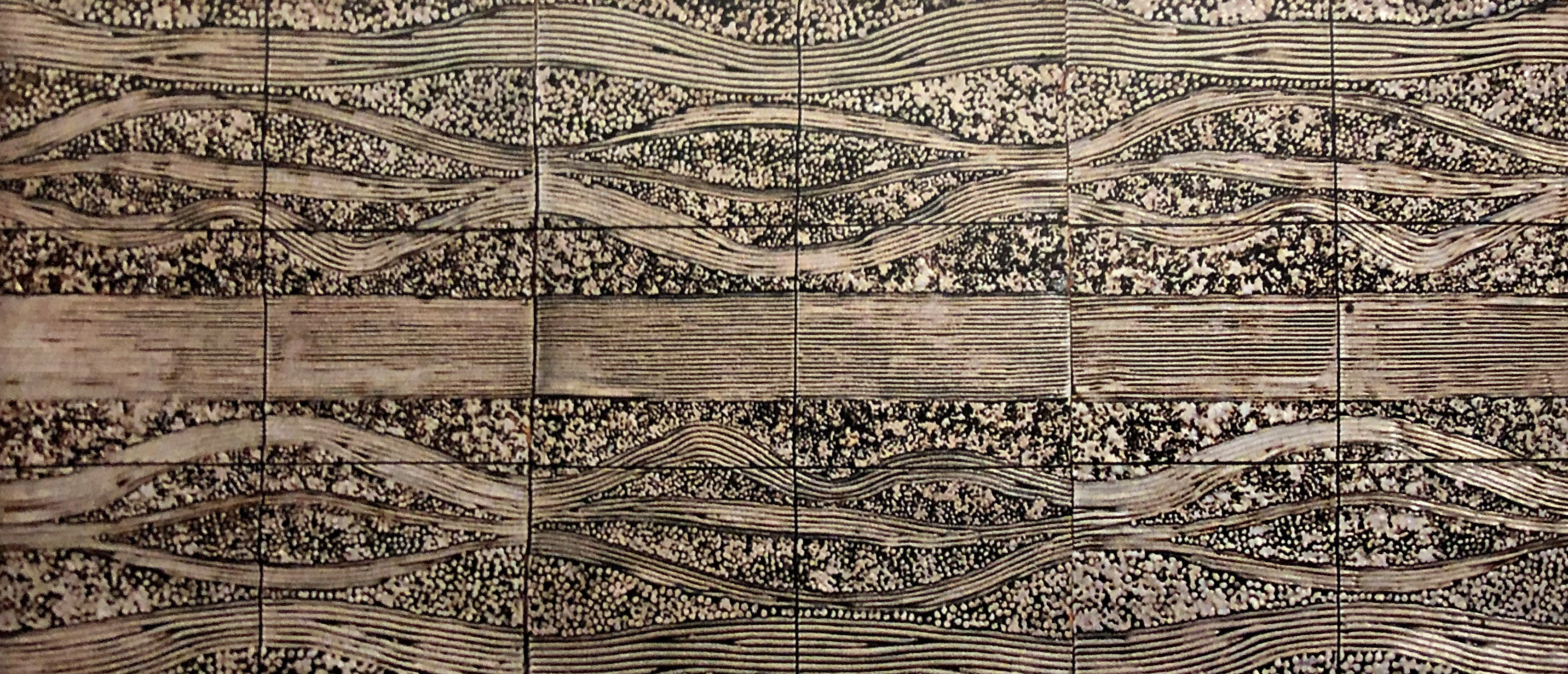
Paesaggio
Salvatore Fornarola, 2006
Terracotta smaltata, 31 x 70 x 1,5 cm Salvatore Fornarola (Penne (PE) 1936 - Fermo (FM) 2014) - Terzogenito di una numerosa
famiglia. Il padre, Pasquale, era giardiniere e custode della Villa Caracciolo.
Qui Salvatore, oltre alla passione per la natura e la botanica, sviluppa le
prime conoscenze di carattere artistico. Infatti, nei saloni della villa si
conservano numerose ceramiche di Castelli, e i vialetti del parco erano ornati
da statue in terracotta a grandezza naturale. Questo primo apprendistato
risulterà essere la pietra miliare della sua carriera, da cui coerentemente egli
prende le mosse. La città di Penne tra le altre numerose scuole, aveva un
importante scuola d’arte, che il ragazzo, di soli dieci anni, frequenta, nella
sezione “legno”. Dopo la scuola dell’obbligo, Salvatore entra nella bottega del
ceramista Gizzi (1954), originario di Castelli. La sua fomazione si va
completando con il possesso pieno delle tecniche plastiche e decorative. In
particolare, le tecniche dell’intaglio sono quelle del “togliere” o “cavare”,
mentre la formatura e la plastica fittile presuppongono la tecnica
dell'”aggiungere”. Considerando che la decorazione ceramica è ai vertici del
fare pittorico, ne consegue che il giovane Fornarola, ormai esperto maestro
d’arte, possiede un invidiabile patrimonio di esperienze, abilità, competenze
sia sui materiali, che sulle tecnologie e sugli stili. GUGLIONESI CULTURA © LUIGI SORELLA [Bibliografia, Pinacoteca d'Arte Contemporanea "Corrado Gizzi": cat. / p. 78]  GUGLIONESIGUIDA CULTURALE E TURISTICA

Landscape Salvatore Fornarola (Penne (PE) 1936 - Fermo (FM) 2014) - Third son of a large family. His father, Pasquale, was the gardener and caretaker of Villa Caracciolo. Here Salvatore, in addition to his passion for nature and botany, developed his first knowledge of an artistic nature. In fact, numerous Castelli ceramics are kept in the halls of the villa, and the paths in the park were decorated with life-size terracotta statues. This first apprenticeship will prove to be the milestone of his career, from which he consistently starts. The city of Penne, among other numerous schools, had an important art school, which the boy, only ten years old, attends, in the "wood" section. After compulsory schooling, Salvatore enters the workshop of the ceramist Gizzi (1954), originally from Castelli. His training is completed with the full possession of plastic and decorative techniques. In particular, the carving techniques are those of "removing" or "excavating", while the molding and clay plastic presuppose the "add" technique. Considering that ceramic decoration is at the pinnacle of pictorial making, it follows that the young Fornarola, by now an expert master of the art, possesses an enviable wealth of experience, skills, expertise both on materials, technologies and styles.
After an initial teaching period in regional professional courses for ceramists, held at the Gizzi workshop, in 1961 he was called to Fermo by the architect Umberto Preziotti, founder of the School of Art, and therefore in search of young teachers for the section " ceramics” of his school, in a city of great cultural traditions, but at the time lacking in specific artistic schools.
Having become a state institute, the Preziotti School still makes use of the decades-long teaching of Fornarola, master of numerous generations of skilled students educated in that laboratory, highly equipped and always in step with the most modern research techniques.
The various technical-stillistic researches conducted within the institute have led the teacher himself to high quality levels. Parallel to these didactic outcomes, Fornarola carries out an intense research work on materials in his private studio, with accentuated freedom of conception, planning and realization, which has allowed him to obtain national and international recognition for at least thirty years. [Bibliography, "Corrado Gizzi" Contemporary Art Gallery: cat. / p. 78]
Alcolizzate
Gaetano Pallozzi, 1995
Acrilico su tela, 80 x 60 cm  GUGLIONESIGUIDA CULTURALE E TURISTICA

Alcolizzate
Gaetano Pallozzi, 1995
Acrilico su tela, 80 x 60 cm Gaetano Pallozzi (Sulmona, 1925-2020) - La sua formazione artistica avviene presso la Scuola d’Arte “G. Mazara” della città natale allorché manifesta subito la sua passione per il disegno e la pittura (prima personale alla Galleria S. Carlo di Napoli nel 1958). La piena maturità si registra intorno agli anni ‘70, dopo un'interessante fase iniziale di ricerca caratterizzata da un cromatismo robusto con cui vengono affrontate tematiche paesaggistiche e sociali. Scene desunte dalla vita quotidiana di provincia sono dipinte con un suggestivo sentimento di solitudine e di esistenziale tormento. Già da quegli anni lo troviamo presente a tutte le più importanti rassegne nazionali: ben quattro edizioni della Quadriennale romana (VII, IX, XI, XIII) nonché i vari Premi Michetti, Avezzano, Sulmona, Il Fiorino, Terni, Villa S. Giovanni, Termoli, Suzzara, le mostre di Arte sacra di Celano, Fermo Viterbo. All’estero va citata la sua partecipazione alla storica esposizione Arte italiana a New York, organizzata dal Ministero degli Affari Esteri nel 1965 e sempre nello stesso anno si registra una sua personale alla Boutique Madison Avenues sempre nella metropoli americana. Lunghissimo l’elenco delle
personali curate dai massimi critici italiani (Venturoli, Bellonzi, Solmi, De Micheli, Micacchi, Tallarico, Passoni, Zeri, Sgarbi, Strinati, Pontiggia e così via) e tenute in spazi pubblici assai qualificati come il Forte Spagnolo all’Aquila, il Palazzo dei Diamanti a Ferrara, il Palazzo dei Capitani ad Ascoli Piceno, la Galleria Civica di Termoli, il Castello Aragonese di Taranto, Castel S. Angelo a Roma. Alla sua attività di pittore Pallozzi unisce quella di operatore culturale. In qualità di Segretario Generale, da anni egli è l’animatore del Premio Sulmona. A ivello storico Pallozzi ha avuto un doveroso riconoscimento nella monumentale Storia dell'arte italiana per generazioni di Giorgio Di Genova (Edizioni Bora — Bologna), un critico che per tanti anni ha collaborato alla varie edizioni del Premio Sulmona. Nel 2006 è invitato a tenere una personale al MUMI (Museo Michetti) di Francavilla al Mare, ove è presentato da Rossana Bossaglia. Nel2007 è invitato al Premio Vasto.
GUGLIONESI CULTURA © LUIGI SORELLA [Bibliografia, Pinacoteca d'Arte Contemporanea "Corrado Gizzi": cat. / p.116]  GUGLIONESIGUIDA CULTURALE E TURISTICA

Alcoholics Gaetano Pallozzi (Sulmona, 1925-2020) - His artistic training took place at the “G. Mazara” of his hometown when he immediately manifested his passion for drawing and painting (first personal exhibition at the Galleria S. Carlo in Naples in 1958). Full maturity is recorded around the 1970s, after an interesting initial phase of research characterized by a robust chromatism with which landscape and social issues are addressed. Scenes taken from the daily life of the province are painted with a suggestive feeling of loneliness and existential torment. Already from those years we find him present at all the most important national reviews: four editions of the Roman Quadrennial (VII, IX, XI, XIII) as well as the various Michetti Awards, Avezzano, Sulmona, Il Fiorino, Terni, Villa S. Giovanni, Termoli, Suzzara, the sacred art exhibitions of Celano, Fermo Viterbo. Abroad, his participation in the historic Italian art exhibition in New York, organized by the Ministry of Foreign Affairs in 1965, should be mentioned, and in the same year he had a one-man show at the Madison Avenues Boutique, also in the American metropolis. The list of personal exhibitions curated by the greatest Italian critics (Venturoli, Bellonzi, Solmi, De Micheli, Micacchi, Tallarico, Passoni, Zeri, Sgarbi, Strinati, Pontiggia and so on) and held in highly qualified public spaces such as the Spanish Fort at the Aquila, the Palazzo dei Diamanti in Ferrara, the Palazzo dei Capitani in Ascoli Piceno, the Galleria Civica in Termoli, the Aragonese Castle in Taranto, Castel S. Angelo in Rome. Pallozzi combines his activity as a painter with that of a cultural operator. As Secretary General, he has been the promoter of the Sulmona Prize for years. At the historical level, Pallozzi received due recognition in the monumental History of Italian art for generations by Giorgio Di Genova (Edizioni Bora - Bologna), a critic who for many years collaborated on the various editions of the Sulmona Prize. In 2006 he was invited to hold a personal exhibition at the MUMI (Museo Michetti) in Francavilla al Mare, where he was presented by Rossana Bossaglia. In 2007 he was invited to the Vasto Prize. [Bibliography, "Corrado Gizzi" Contemporary Art Gallery: cat. / p.116]
Risposte
Daniele De Vincentis, 2006
Olio, 63 x 100 cm  GUGLIONESIGUIDA CULTURALE E TURISTICA
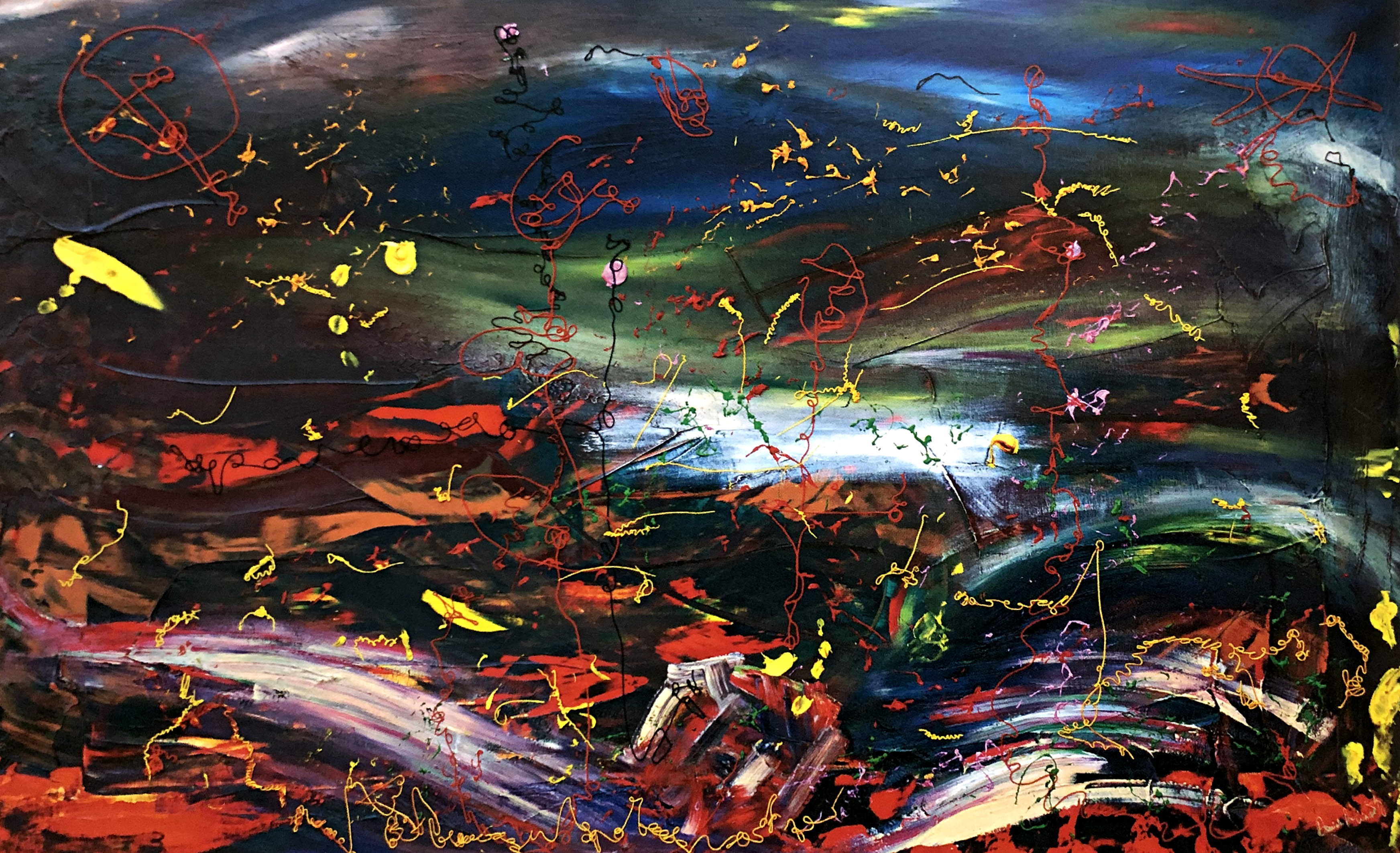
Risposte
Daniele De Vincentis, 2006
Olio, 63 x 100 cm Daniele De Vincentis (Ascoli Piceno 1975) - Manifesta fin dalla prima infanzia l’interesse per le forme di linguaggio comunicativo: il disegno, come è di consuetudine nell’infanzia e l’apprezzamento per la musica. La manipolazione, la meccanica e la lavorazione del legno sono componenti che accompagneranno De Vincentis per tutta l’infanzia. Durante l’adolescenza i rapporti scolastici si dissolvono nella confusione totale, mentre le volontà artistiche acquistano corposità concretizzandosi e delineandosi nelle varie discipline. Musica, canto, poesie e disegni arricchiscono il suo curriculum, poi a 18 anni il ritorno agli studi nell’Istituto Statale d’Arte di Ascoli, e quindi fotografia, scultura e pittura allargano gli orizzonti artistici. Attualmente De Vincentis lavora in campo artistico come grafico e fotografo, mentre la pittura e la musica sono per lui una costante. Frequenta assiduamente lo studio del maestro Vittorio Amadio in Ascoli Piceno. Nel 2006 ha preso parte al Premio Razzano a Benevento.
GUGLIONESI CULTURA © LUIGI SORELLA [Bibliografia, Pinacoteca d'Arte Contemporanea "Corrado Gizzi": cat. / p. 62]  GUGLIONESIGUIDA CULTURALE E TURISTICA

Answers Daniele De Vincentis (Ascoli Piceno 1975) - Since early childhood, he has shown an interest in forms of communicative language: drawing, as is customary in childhood, and an appreciation for music. Handling, mechanics and woodworking are components that will accompany De Vincentis throughout his childhood. During adolescence, scholastic relationships dissolve in total confusion, while artistic wills acquire body, materializing and delineating themselves in the various disciplines. Music, singing, poems and drawings enrich his curriculum, then at 18 he returned to his studies at the State Art Institute of Ascoli, and then photography, sculpture and painting broadened his artistic horizons. Currently De Vincentis works in the artistic field as a graphic designer and photographer, while painting and music are constants for him. He assiduously frequents the studio of master Vittorio Amadio in Ascoli Piceno. In 2006 he took part in the Premio Razzano in Benevento.
[Bibliography, "Corrado Gizzi" Contemporary Art Gallery: cat. / p. 62] |
Progetto di cultura digitale di Luigi Sorella

